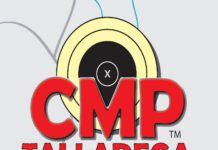Hunting with an airgun is one of the most enjoyable pastimes that I have run across in the last decade or so. I have been an avid hunter since I was old enough to keep both ends of the rifle off the ground, but in the last several years, airguns have grabbed my attention as the tool of choice for my hunting forays.
Whenever you hunt with a firearm or airgun, one of the more important items you will need is a suitable round of ammunition for the gun of your choice. In airguns, this translates into a pellet. A pellet is a projectile that looks very much like a badminton shuttlecock, or birdie, in that the vast majority of pellets these days have a skirt on them. The purpose of the skirt is to engage the rifling of the barrel, and give the air a platform to push as it is routed through the internals of the gun. In a spring-piston gun, the air is quickly compressed by a piston, while in a pneumatic or CO2 gun, the air or gas is released through a valve of one type or another.
In the picture, you can see three different pellets offered by Umarex USA. There are others in addition to these, but for the use of this article, well discuss these three here. They are, from left to right, the RWS Superdome, the RWS Super H-Point, and the RWS Supermag. The Superdome is the round-nosed pellet, while the Super H-Point is the hollow point pellet. The Supermag is the wadcutter-style pellet on the right.
Now, of the three pellets seen here, which one would you use for which hunting scenario? Well, the best answer, of course, is which pellet provides the greatest accuracy in yourairgun! Without hitting the target, the type of projectile you use is academic at best. But there will be hunting situations that call on a particular kind of pellet, and Ill describe a couple of scenarios for you to ponder.
For all-around use, it is hard to beat the domed pellet. It offers great accuracy, carries well at greater distances, and provide excellent energy retention when shooting live targets. I use domed pellets in the vast majority of my hunting scenarios….squirrel hunting, avian pest control, and targets of opportunity while Im in the field. However, there are certain times when I switch to the Super H-Point.
If the target in question is a bit tougher than my normal air gun prey, lets say a groundhog or possum, or maybe a nutria rat in the south, I may switch to a hollow point pellet such as the RWS Super H-Point in order to maximize the lethal damage upon impact. One thing I want readers to realize before using a hollow point is that you need to be pushing that pellet along at a pretty good clip before you realize any advantage over another style pellet. Hollow point pellets WILL expand, but they need velocity at the point of impact in order to do that. So use your more powerful airguns in order to gain the greatest amount of usefulness from the design of the hollow point pellet. If you dont have the required velocity, then you are essentially shooting a wadcutter.
Wadcutter pellets, such as the RWS Supermag, are fantastic pellets for target shooting. They cut nice, round holes in the cardstock targets used in competition, making the scoring that much easier. But there are hunting scenarios that call for wadcutters, making them the best pellet for the job.
The cleaned skull of a raccoon after being shot with an RWS Superdome. (pellet still lodged in the skull)
From time to time, I have the chance to eradicate avian pests such as English sparrows and European starlings from barns, store fronts, and other areas that dont qualify for the term hunting afield. In situations like this, over-penetration is the enemy of the shooter. There isnt a farmer alive that will appreciate your shooting holes in his barn roof because you used the wrong ammo in the wrong gun! So when I have delicate shooting opportunities that call for precise application of force to a light-bodied target, I use the RWS Supermag, or wadcutter. The broad frontal surface of this pellet helps in containing the over-penetration of the pellet in the body of a sparrow, starling, or rat. Coupled with a lower-powered airgun, you can select your shots with more confidence since you are less likely to shoot a hole in the roof. It takes some practice, but if you work at it, you will be able to do some amazing pest control without any collateral damage to property or merchandise in a store, barn, or other public venue.
It wasnt long ago that I had a raccoon raiding my bird feeders. I finally caught up with him one evening, and used an RWS Superdome to end his raiding forays. On the right, you can see a picture of the cleaned raccoon skull, complete with the pellet still stuck in the bone structure of the head. The kill was clean, quick, and effective. The raccoon didnt suffer needlessly, and I wasnt left with a wounded, upset animal on my hands to deal with. Combining the right pellet with the right hunting or pest control situation makes your airgun shooting just that much more enjoyable. So pick the right pellet, and head out to the field!
Or, if you want to try a variety of different pellets at the same time to see which kind best suits your different scenarios, think about trying the pellet sampler package, which contains the Superdome and Super-H Point mentioned in the above article, along with the RWS Meisterkugeln (match grade accuracy), RWS Hobby (balanced for all shooting situations), and RWS Superpoint (increased penetration). This would give you the opportunity to try a mix of pellets for shooting situations that might come up in the future.


























